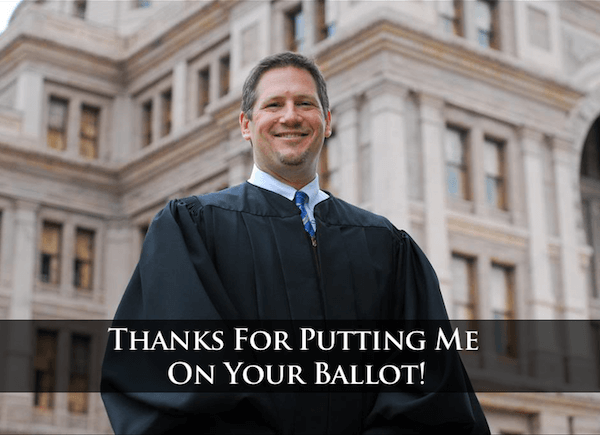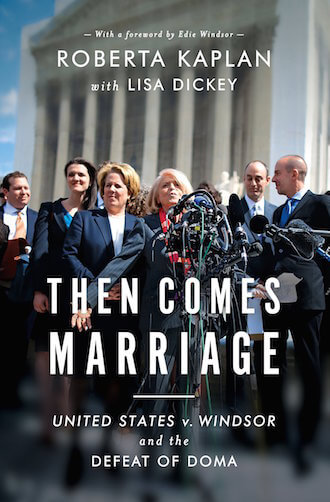Mary Bonauto, the attorney from Gay & Lesbian Advocates & Defenders who argued the marriage equality case, outside the Supreme Court before the April 28 session began. | DONNA ACETO
Marriage equality’s day of reckoning finally arrived at the United States Supreme Court when, on April 28, it heard oral arguments in Obergefell v. Hodges, the consolidated appeals from plaintiffs in four states –– Ohio, Michigan, Tennessee, and Kentucky –– whose victories in federal district court were reversed by the Sixth Circuit Court of Appeals on November 6.
Though most court observers have agreed there was a good likelihood that the Sixth Circuit would in turn be reversed and a national right to marriage for same-sex couples established, the swing justice, Anthony M. Kennedy, Jr., offered no clear signal from his questioning and comments about which way he was leaning. At times, he appeared skeptical about the plaintiffs’ claims, at other times supportive.
The argument was broken down into two parts –– with consideration first about whether states are obligated under the US Constitution to allow same-sex couples to marry, and then about whether they are required to recognize legal same-sex marriages from other jurisdictions. Both sides chose one attorney to represent them on each of the two questions, and Solicitor General Donald B. Verrilli, Jr., also appeared on behalf of the Obama administration, arguing in support of the same-sex couple petitioners.
Swing justice holds back from offering clear signal he’s on board with marriage equality
Mary Bonauto, the Civil Rights Project director at the Boston-based Gay & Lesbian Advocates & Defenders, led off the argument on the right to marry question. This was Bonauto’s first Supreme Court appearance, though her credentials include the very first marriage equality victory before the Massachusetts Supreme Judicial Court in 2003.
As Bonauto opened, it quickly became clear that the four Democratic appointees to the court –– Justices Ruth Bader Ginsburg, Stephen Breyer, Sonia Sotomayor, and Elena Kagan –– were likely votes in favor of same-sex couples having the same fundamental right to marry as different-sex couples.
Chief Justice John Roberts, meanwhile, quickly moved to dispel speculation by some commentators that he was a potential marriage equality vote, as he suggested that what the plaintiffs were seeking was not just “to join the institution, you’re seeking to change what the institution is.” He characterized “the opposite-sex relationship” as “the fundamental core of the institution” of marriage, and he signaled opposition to the idea that judges rather than legislatures or the voters themselves should decide whether to alter that arrangement.
As expected, Justice Antonin Scalia weighed in with arguments familiar to anybody who read the Sixth Circuit opinion by Judge Jeffrey Sutton, who is one of his “originalist” acolytes. Scalia asserted that the question before the court was not “whether there should be same-sex marriage,” but rather “who should decide the point.” He clearly signaled his view that it should be decided by the democratic process of voting and legislating, not by judges.
None of Justice Samuel Alito’s questions or comments suggested any real sympathy for the plaintiffs’ position either, and, true to form, Justice Clarence Thomas refrained from asking any questions or offering comments.
With the outcome likely to fall to Kennedy’s vote, his opening sally was not calculated to reassure those counting on him to quickly embrace the trajectory of his historic prior opinions for the court in the 2013 Defense of Marriage Act and the 2003 sodomy cases.
“This definition [of marriage] has been with us for millennia,” he pointed out. “And it’s very difficult for the Court to say, oh, well, we know better.”
At the same time, he noted the time elapsed between the Supreme Court’s decision striking down racial segregation in public schools and its subsequent ruling ending laws against interracial marriages was “about the same” as the time between its sodomy ruling and it now taking up the same-sex marriage question.
“And so there’s time for the scholars and the commentators –– and the bar and the public –– to engage in it,” he pointed out.
Kennedy came closer to tipping his hand in the direction of the same-sex couples when John Bursch, the Michigan solicitor general, stood up to argue in defense of the four states’ marriage bans. Kennedy pressed him to explain how allowing same-sex couples to marry would harm “conventional marriage,” but he left it to the other justices, particularly Breyer and Kagan, to pursue the point. Still, when Bursch argued that the state has a particular interest in assuring bonds between children and their biological parents, Kennedy characterized the idea that “only opposite-sex couples can have a bonding with the child” as “just a wrong premise.”
Kennedy seemed particularly indignant when Bursch discounted the significance of the dignity the state bestows on a couple by according them the right to marry. The Michigan solicitor general suggested the state has no particular interest in this, and is primarily concerned with children not the relationship between the two adults marrying. This was not a good strategic move on Bursch’s part, given the emphasis Kennedy put on the issue of “dignity” in his DOMA opinion.
“I don’t understand this not dignity-bestowing,” Kennedy commented. “I thought that was the whole purpose of marriage. It bestows dignity on both man and woman in a traditional marriage. It’s dignity bestowing, and these parties say they want to have that same ennoblement.”
But Bursch doubled down in his argument, insisting, “The state has no interesting in bestowing or taking away dignity from anyone, and certainly it’s not the state’s intent to take dignity away from same-sex couples or from anyone based on their sexual orientation.”
Kennedy response was sharp: “Well, I think many states would be surprised, with reference to traditional marriages, they are not enhancing the dignity of both the parties.”
Solicitor General Verrilli focused his argument entirely on the equal protection rights of same-sex couples, and he was pushed during the questioning on his failure to make the alternative argument, that they enjoy a fundamental right to marry. It quickly became clear that for the conservative justices the fundamental right to marry argument is a non-starter because it immediately invites claims for the right to polygamous marriage. Alito posed a hypothetical about two men and two women seeking to marry as a foursome, and Scalia also harped on this issue.
One absurd point arose when Scalia questioned Bonauto about whether a minister might be required to perform same-sex marriages against their religious beliefs. She responded that the First Amendment would shield a minister from such an obligation, but Scalia insisted that if there were a constitutional right to marriage that might trump a free exercise of religion defense. Bonauto pointed out that no minister had been prosecuted for refusing to perform marriages in marriage equality states, and Justice Kagan jumped in with the example of rabbis who refuse to perform marriages between Jews and non-Jews. Scalia here was clearly being facetious, since the First Amendment is unambiguous on this point and no court would ever order a religious officiant to perform weddings violating their religious beliefs.
One note of unexpected drama erupted after Bonauto finished her allotted time for argument, when an audience member burst into a diatribe about hell and abomination until escorted out by security officials. Chief Justice Roberts seemed ready to delay Verrilli’s argument, but the solicitor general indicated he was ready to press forward. Before Verrilli got started, Scalia offered the oddly cryptic observation that the outburst was “refreshing.” Perhaps he was suggesting the court seriously consider religious objections to same-sex marriage.
Bonauto closed up consideration of the first question with a rebuttal argument so precise and well-focused she was not interrupted for any questions as she highlighted the basic inconsistencies in Bursch’s arguments.
The Question of Marriage Recognition The court next turned to the issue of whether states are required by the 14thAmendment to recognize same-sex marriages contracted in other states. Representing the same-sex couple petitioners, Douglas Hallward-Driemeier, the head of the Supreme Court litigation practice at the law firm of Ropes & Gray LLP, was quickly interrupted by Alito.
“I am somewhat surprised by the arguments you made in your brief,” he said, “because they are largely a repetition of the arguments that we just heard with respect to Question 1. I thought the point of Question 2 was whether there would be an obligation to recognize a same-sex marriage entered into in another state where that is lawful even if the state itself, constitutionally, does not recognize same-sex marriage.”
This quickly clarified a mystery that had confounded legal observers. Why the second question, since it seemed obvious that if same-sex couples have a right to marry the right to recognition of out-of-state marriages would naturally follow? This question left open the possibility that the court could rule against the couples on their right to marry, but then consider whether states might nonetheless be obliged to recognize their marriage if performed legally out of state.
Alito and Scalia energetically followed up with questions and hypotheticals about forcing states to recognize the validity of marriages they would not allow within their own borders. Even Kennedy joined in briefly, suggesting that if states were justified in denying a right to marriage they might also be allowed to refuse to recognize the same marriage from elsewhere.
It fell to Ginsburg to jump in and nail down the point that if the plaintiffs won the right to marry on Question 1, “then the argument is moot.” Hallward-Driemeier agreed with Ginsburg, as Joseph Whalen, Tennessee’s associate solicitor general arguing for the four states, also conceded.
Hallward-Driemeier emphasized the harms to same-sex couples who married and had children in other states and then might be moved by an employer –– the starkest example being the military as the employer –– to a state that didn’t recognize their marriage. This point seemed well calculated to appeal to Kennedy, who articulated a concern for the welfare of children of same-sex couples in his DOMA opinion.
When Whalen got up to defend the recognition bans, Scalia appeared to surprise him by raising the Constitution’s Full Faith and Credit Clause, which has barely been mentioned over the past two years of marriage recognition litigation. Lower federal courts have instead focused on the Equal Protection Clause and generally found states had no rational basis for recognizing different-sex marriages from other states but refusing to recognize same-sex marriages. After the 1996 enactment of DOMA, which authorized states to deny recognition to same-sex marriages from other jurisdictions, some scholars observed that the Full Faith and Credit Clause had not traditionally been invoked in marriage recognition cases, that it was not really clear it even applied to the question of marriages.
But Scalia pressed the point, and the matter soon drew other justices into what became a rather esoteric discussion. At one juncture, there was even some indication, if perhaps just fleeting, that Chief Justice Roberts might see an application of the Full Faith and Credit Clause to Question 2, which could now feed speculation that even if the court were to rule adversely on same-sex couples having a constitutional right to marry, there is a potential majority, including some conservative justices, in favor of a marriage recognition mandate on the states. But, again, that signal was at best fleeting.
When Whalen picked up on Bursch’s argument about the state’s interest in maintaining the “biologically-based” core of its understanding of parenthood as a reason to privilege different-sex couples over same-sex couples in giving access to marriage, Justice Sotomayor jumped in to note that Tennessee’s adoption laws put parents of adoptive parents on par with biological parents.
“Oh, but you do that for adoptions,” she said. “What’s the problem? This is a really big deal?”
Whalen responded, “It is a big deal, Your Honor, because you are changing the way the state defines a parent. And in the adoption context, you have to understand adoption and the traditional definition of marriage, they work in tandem. They work together. As Mr. Bursch described, the objective with regard to marriage is to link children with their biological parents. When that breaks down, then there’s adoption.”
The key policy goal in Tennessee as it relates to marriage, then, is to preserve the biological bond between a child and their parents, Whalen was arguing.
Sotomayor responded by asking whether a state can refuse to recognize a birth certificate issued by another state that identifies same-sex spouses as the parents of a child.
“Do you think the word ‘records’ in the Constitution includes birth certificates,” she said, referring to a word found in the Full Faith and Credit Clause. When Whalen responded in the affirmative, Sotomayor continued, “So California without any reason, no suspicion of fraud, no anything, could it refuse to recognize another state’s birth certificate? Records to me has to have a meaning.”
“Record has a meaning,” Whalen responded. “It does, your Honor.”
“But if a birth certificate were to be a record,” asked Sotomayor, “don’t you think a marriage certificate –– it’s an official act of a state?”
Whalen acknowledged as much, but then insisted the two situations were not comparable, saying, “I think that the laws that allowed that marriage to occur, when they are different fundamentally with the laws of a state like Tennessee, preclude the application of that same principle from one state to the other.”
Hallward-Driemeier’s rebuttal at the close of the Question 2 argument, like Bonauto’s on Question 1, was so tightly focused that none of the justices interrupted with questions. He concentrated on demonstrating the real harms suffered by same-sex couples, exemplified by two of the plaintiff couples who had relocated and been denied recognition of their marriages –– in one case, in the context of emergency medical care for one of their children. Again, the appeal here was to a major concern of Kennedy’s.
Hallward-Driemeier ended his rebuttal with the stark evocation of Jim Obergefell’s struggle to be properly recorded as a surviving spouse on the death certificate of his husband, John Arthur.
Reading the Tea Leaves Commentators and analysts will likely pick over the transcript and audio recordings for the next few months trying to find signs about how the case will turn out, but they may be disappointed to find that Kennedy had much less to say than those justices whose positions are much more predictably pro or con. On Question 2, in particular, there is very little to work with; there, he barely spoke at all.
The most hopeful sign for marriage equality proponents springs not from these arguments, but more from the court’s prior actions –– first, in denying review of the Fourth, Seventh, and 10th Circuit pro-marriage equality rulings last October 6, which allowed same-sex marriage to go into effect in every state in those circuits, and later in rejecting stay petitions from several states in the Ninth Circuit states, as well as from Florida and Alabama, in cases not yet reviewed by the 11th Circuit Court of Appeals. These actions seemed a clear indication of a court majority on board with marriage equality, since they allowed the map to expand to 37 states representing 70 percent of the population.
An adverse ruling on Question 1 –– the right to marry question –– would be a daunting proposition liable to generate frenzied litigation over the status of thousands of marriages performed in the 18 states where same-sex couples first became eligible to wed after October 6.
Viewed from that perspective, it seems highly likely Kennedy will overcome any qualms he might have about suddenly abandoning “millennia” of different-sex marriage traditions in favor of avoiding the harms suffered by same-sex couples and their children –– in terms of financial and emotional well-being and dignity –– when their families are denied the benefits of marriage.



































